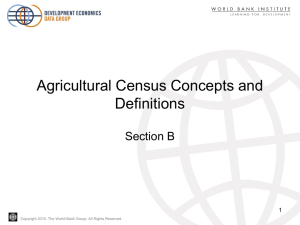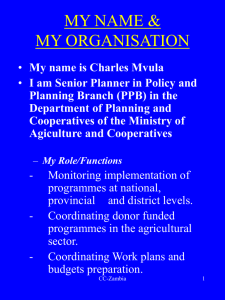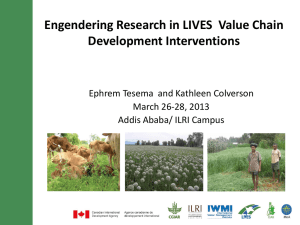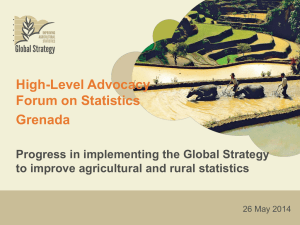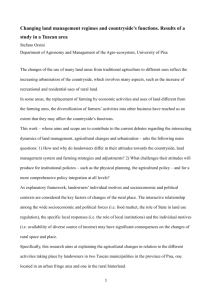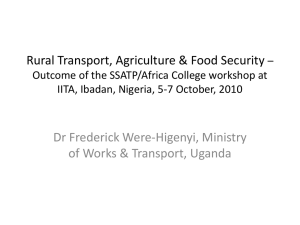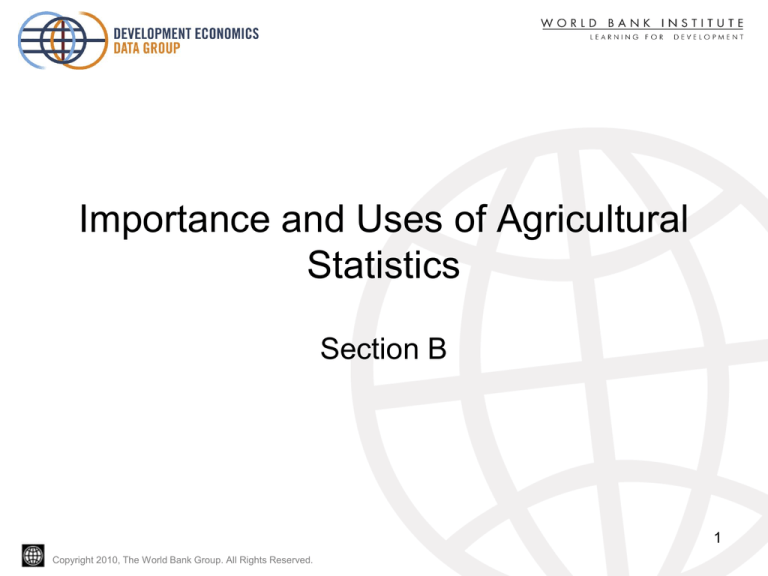
Importance and Uses of Agricultural
Statistics
Section B
1
Copyright 2010, The World Bank Group. All Rights Reserved.
Conceptual Framework to Improve
Agricultural Statistics
In order to respond to increasingly diverse data
demands, international organizations have
developed the conceptual framework to
include the social, environmental and
economic aspects of agricultural activities.
2
Copyright 2010, The World Bank Group. All Rights Reserved.
Three Pillars of the Conceptual
Framework
1. Identify a minimum set of core data
2. Integrate agriculture into the national
statistical system
3. Improve sustainability through governance
and capacity building
3
Copyright 2010, The World Bank Group. All Rights Reserved.
What is an Integrated Statistical
System?
• All statistics in a country functioning as part of
a whole
– Common definitions and concepts
– Coordinated planning for efficient use of
resources
– Common sampling frames
4
Copyright 2010, The World Bank Group. All Rights Reserved.
The Conceptual Framework for
Agricultural Statistics
5
Copyright 2010, The World Bank Group. All Rights Reserved.
Scope of Agricultural Statistics
• Use international standards to guide
expanded definitions and concepts
• SEEA
• ISIC
• CPC
• Coordination among agencies responsible for
various areas is necessary for an integrated
national statistical system
6
Copyright 2010, The World Bank Group. All Rights Reserved.
Coverage of Agricultural Statistics
• Units of enumeration:
– Household agricultural holdings
– Agricultural establishments
– Rural households
• Relationships for analysis
– Household
– Agricultural holding
– Land parcel
7
Copyright 2010, The World Bank Group. All Rights Reserved.
Identifying the Core Data Set
• Select data items that:
– Contribute to multiple indicators
– Are important to national accounts
– Monitor progress toward MDGs
– Represent significant land use
– Contribute to farm and household welfare
– Have an effect on the environment
8
Copyright 2010, The World Bank Group. All Rights Reserved.
Core Crop Items
Wheat, maize, barley, sorghum, rice, sugar cane,
soybeans and cotton
– Area planted and harvest, yield and production
– Amounts in storage
– Area of cropland irrigated
– Producer and consumer prices
– Amounts utilized for own consumption
– Early warning indications
9
Copyright 2010, The World Bank Group. All Rights Reserved.
Core Livestock Items
Cattle, sheep, pigs, goats and poultry:
– Inventory and annual births
– Products (meat, milk, eggs and wool)
– Net trade, imports and exports
– Producer and consumer prices
10
Copyright 2010, The World Bank Group. All Rights Reserved.
Core Aquaculture Items
Core products determined by contribution to food
supplies and land/water usage
• Aquaculture:
– Area cultured, production, prices, and net trade or
imports and exports
• Capture fisheries:
– Quantity landed/discarded, days fished, amounts
processed for food/nonfood, prices, and imports and
exports
11
Copyright 2010, The World Bank Group. All Rights Reserved.
Core Forestry Items
Core forestry items should reflect major land
use and income provision:
– Area in woodlands and forests
– Quantities of timber/trees removed
– Prices for agricultural holding products and uses
– Prices for non-agricultural holding products and
prices
12
Copyright 2010, The World Bank Group. All Rights Reserved.
Core Agricultural Inputs
Includes labor, chemical, water, energy and
investments in agriculture (i.e. equipment)
– Fertilizers and pesticides used by quantity
– Water and energy consumed
– Capital stocks by purpose
– Workers hired
– Employment of household members
13
Copyright 2010, The World Bank Group. All Rights Reserved.
Core Socioeconomic Data
Agricultural and rural households’
characteristics and household income by
source, including periodic data on:
– Number of households and population
– Age and sex
– Employment
– Education levels
14
Copyright 2010, The World Bank Group. All Rights Reserved.
Environmental Items
Land cover can demonstrate the environmental
impact of agriculture with remote sensing showing
land cover classified into:
–
–
–
–
Cropland
Forest
Grassland
Wetlands
– Settlements
– Water
– Other
15
Copyright 2010, The World Bank Group. All Rights Reserved.
Rural Development Items
Public expenditures on subsidies and
infrastructure in rural areas such as health
and education, including:
– Roads
– Transport
– Communications
– Agricultural extension services
16
Copyright 2010, The World Bank Group. All Rights Reserved.
Setting National Priorities
1. Include significant items in the country’s value
of production
2. Items with varying production levels if they are
a source of risk for vulnerable groups
3. Items that account for majority of land use
4. Exclude items produced by few holdings
17
Copyright 2010, The World Bank Group. All Rights Reserved.
Developing the National Statistical Plan
• Determine appropriate rural development
indicators, considering MDGs
• For each core and additional item determine:
– Frequency of collection
– Level of detail
– Coverage
• Consultation with stakeholders and data users
18
Copyright 2010, The World Bank Group. All Rights Reserved.
Decision Table Example
Data Item
Major
Production
areas only –
by holdings
National
coverage of
production
by holdings
Within country
administrative
areas – by
holding
Inclusive of
Households
and HH plots
Crop
Annual
Annual
Decennial
census
Decennial
census
Livestock
Biannual
Biannual
Decennial
census
Decennial
census
Aquaculture
Forestry…
19
Copyright 2010, The World Bank Group. All Rights Reserved.
Section B Quiz
1. In your own words, what is the conceptual
framework?
2. What is an integrated system of statistics?
3. What are the main categories of
recommended core data items (hint: there
are 8 total)?
4. What must be balanced when setting
national priorities?
20
Copyright 2010, The World Bank Group. All Rights Reserved.





